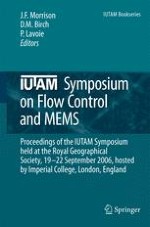2008 | Buch
IUTAM Symposium on Flow Control and MEMS
Proceedings of the IUTAM Symposium held at the Royal Geographical Society, 19–22 September 2006, hosted by Imperial College, London, England
herausgegeben von: J. F. Morrison, D. M. Birch, P. Lavoie
Verlag: Springer Netherlands
Buchreihe : IUTAM Bookseries (closed)
